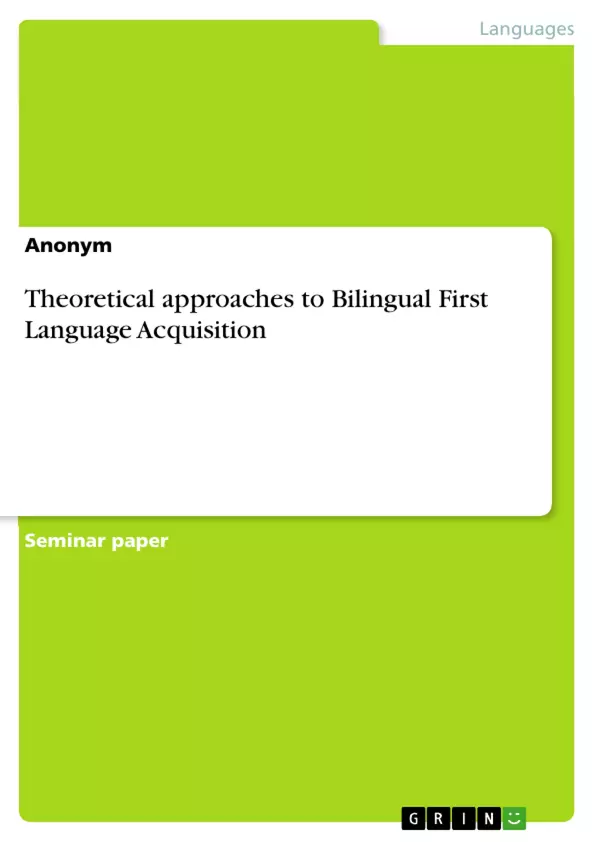In today's era, society becomes more and more globalized, with the increase of languages in contact. As a result, more and more people get in touch with, learn and use new languages whether for private or occupational reasons. Therefore, the interest in studying people who use two or more languages in an equal manner has greatly increased. These people are called Bi- or Multilinguals. Due to the described development of society, the number of children growing up in multilingual communities and bilingual families is also increasing. Children achieve languages remarkable quickly and it is even more remarkable when they learn two languages simultaneously from the very beginning of their life.
The central point of interest for this paper is different theoretical approaches to the development of BFLA by children. Since the topic is studied for centuries, this paper has, of course, no claim for completeness. Thus the focus will be on Annick DeHouvwer’s work to Bilingual first language acquisition.
In Chapter 2 the mentioned work by DeHouvwer is introduced and explained on the basis of terminological definition. The following points specifie the importance of the environment for Bilingual First Language Acquisition before an overview of the major linguistic developments is made.
The focus of the third chapter is on three theories that aim at explaining the complex matter of Bilingual First Language Acquisition process. After that, these theories are compared with one another under several points of view. Subsequently, one of the named theories is applied on the introduced work of Annick DeHouvwer to show that it can certainly be applied.
Inhaltsverzeichnis (Table of Contents)
- Introduction
- Bilingual First Language Acquisition (BFLA)
- The Environment of BFLA
- Overview of language development by bilingual children
- Theories of BFLA and their Comparison
- Comparison of theoretical approaches
- Comparison of theoretical approach to DeHouvwer's milestones of BFLA
- Conclusion
Zielsetzung und Themenschwerpunkte (Objectives and Key Themes)
This paper delves into various theoretical approaches to the development of Bilingual First Language Acquisition (BFLA) in children. It focuses on Annick DeHouvwer's work, providing a comprehensive overview of BFLA. The paper aims to understand how children become bilingual from birth and how their environment shapes their language development.
- The impact of the environment on BFLA
- Different theoretical perspectives on BFLA
- Comparison of theoretical approaches to BFLA
- Application of theoretical approaches to DeHouvwer's milestones of BFLA
- The importance of studying BFLA in young children
Zusammenfassung der Kapitel (Chapter Summaries)
The first chapter introduces the concept of BFLA and defines key terms. It highlights the increasing globalized society and the growing interest in multilingualism, particularly in children. The chapter also emphasizes the importance of studying BFLA in children under six, as they are considered "natural linguistic laboratories" for understanding the process of acquiring two languages simultaneously.
Chapter two focuses on the environment of BFLA, explaining the diverse factors influencing language acquisition. It discusses the role of verbal interaction, language presentation, and frequency of language exposure in shaping a child's bilingual development.
Schlüsselwörter (Keywords)
This paper focuses on Bilingual First Language Acquisition (BFLA), emphasizing the environment and theoretical perspectives surrounding the development of two languages in children from birth. The paper also explores the importance of DeHouvwer's research on BFLA, including her key milestones and concepts. Other key terms include monolingual first language acquisition (MFLA), early second language acquisition (ESLA), verbal interaction, language presentation, and frequency of language exposure.
- Quote paper
- Anonym (Author), 2016, Theoretical approaches to Bilingual First Language Acquisition, Munich, GRIN Verlag, https://www.grin.com/document/374511



